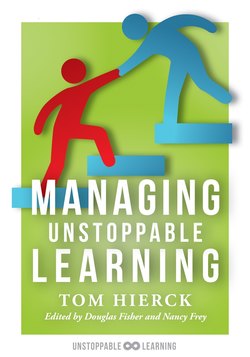Читать книгу Managing Unstoppable Learning - Tom Hierck - Страница 9
На сайте Литреса книга снята с продажи.
ОглавлениеForeword
By Douglas Fisher and Nancy Frey
“Don’t smile before winter break.”
Do you recall getting that ridiculous piece of advice as a new teacher? We can only shake our heads at how misguided that directive was. Our field has progressed in many ways since we were in our teacher preparation programs so long ago (before the Internet was invented). Members of the teaching profession in the 21st century look for evidence of practice, align to content standards, and collaborate in professional learning communities. Yet when it comes to managing the learning environment, teachers can sometimes retreat to outdated habits. When confronted with an uncooperative student, the old tapes in their heads turn on: “How did my third-grade teacher handle this situation? She sent the student to the principal’s office!” And so they repeat what they witnessed twenty or more years ago, even though it is unlikely to yield any long-term positive result.
Tom Hierck reminds us that managing a classroom is fundamentally, and foundationally, about the quality of the relationships between and among adults and students. The climate in the classroom, as Hierck notes, is about “creating the optimal learning environment that allows every student to experience success regardless of his or her current status, approach, baggage, or disposition” (p. 10). Therefore (and rightly so), issues related to problematic and unproductive behaviors are not raised until chapter 5. So much of what constitutes effective management comes from the investments educators proactively make such that students understand the ways of work, how to seek help, and how they learn about themselves through their interactions with others.
Too often, discussions about relationships and management never occur. Thus, a teacher struggling with maintaining positive relationships with students is left alone to figure things out. That breeds isolation and despair on the part of the teacher, who is left to fend for him- or herself. In a short time, those feelings of discouragement foment, and before long, the blame is shifted to students: “It’s not me, it’s the kids. They’re [fill in the blank with the excuse of your choice].”
This hands-off approach can result in misaligned schoolwide procedures and processes. In these schools, classrooms function as silos, with educators giving relatively little attention to how the culture and climate of the school seep from the hallways into the classroom. However, educators should view management as a schoolwide investment. In a systems-driven organization, school leaders consider carefully how the climate of the school impacts what teachers are able to do in the learning environment. It isn’t a one-way street—there is a reciprocal relationship between classroom and school climate. A problematic relationship between a single teacher and his or her students negatively impacts the entire school. Likewise, when punitive measures to control students drive a school culture, it undermines wise and supportive teachers.
Managing Unstoppable Learning shines a light on the importance of building relationships, investing in a positive culture, and teaching students how to best interact with others. You will find a blend of practical tips and thought-provoking questions that beg for discussion. In fact, we hope you will read this book in the company of colleagues. We imagine you will discover what we have found to be true: people go into teaching to make a positive difference in the lives of students. The impact we have on young people is amplified when we engage with one another in material ways about our practices.
